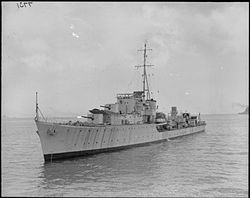 HMS Oribi | |
| History | |
|---|---|
| Name | Oribi |
| Ordered | 3 September 1939 |
| Builder | Fairfield Shipbuilding and Engineering Company, Govan |
| Laid down | 15 January 1940 |
| Launched | 14 January 1941 |
| Commissioned | 5 July 1941 |
| Decommissioned | 1 January 1946 |
| Honours and awards |
|
| Fate | Sold to Turkey [1] |
| Name | Gayret |
| Acquired | 1946 |
| Fate | Scrapped 1965 |
| General characteristics | |
| Class & type | O-class destroyer |
| Displacement | 1,610 long tons (1,640 t) (standard) |
| Length | 345 ft (105.2 m) (o/a) |
| Beam | 35 ft (10.7 m) |
| Draught | 13 ft 6 in (4.1 m) |
| Installed power |
|
| Propulsion | 2 × shafts; 2 × geared steam turbines |
| Speed | 37 knots (69 km/h; 43 mph) |
| Range | 3,850 nmi (7,130 km; 4,430 mi) at 20 knots (37 km/h; 23 mph) |
| Complement | 176+ |
| Armament |
|
HMS Oribi (G66) was an O-class destroyer of the Royal Navy. Following the style of her sister ships, she was named with a word beginning with O. She was to have been named HMS Observer; because her building was sponsored by the South African government, she was named HMS Oribi, after the oribi, a South African antelope. In 1942, after a successful warship week, the ship was "adopted" by Havant, Hampshire.